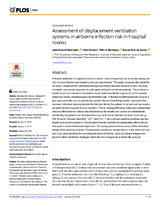Mostrar el registro sencillo del ítem
Assessment of displacement ventilation systems in airborne infection risk in hospital rooms
| dc.contributor.author | Villafruela, José Manuel | |
| dc.contributor.author | Olmedo Cortés, Inés | |
| dc.contributor.author | Berlanga, Félix | |
| dc.contributor.author | Ruiz de Adana, Manuel | |
| dc.date.accessioned | 2019-03-26T11:13:44Z | |
| dc.date.available | 2019-03-26T11:13:44Z | |
| dc.date.issued | 2019 | |
| dc.identifier.uri | http://hdl.handle.net/10396/18296 | |
| dc.description.abstract | Efficient ventilation in hospital airborne isolation rooms is important vis-à-vis decreasing the risk of cross infection and reducing energy consumption. This paper analyses the suitability of using a displacement ventilation strategy in airborne infection isolation rooms, focusing on health care worker exposure to pathogens exhaled by infected patients. The analysis is mainly based on numerical simulation results obtained with the support of a 3-D transient numerical model validated using experimental data. A thermal breathing manikin lying on a bed represents the source patient and another thermal breathing manikin represents the exposed individual standing beside the bed and facing the patient. A radiant wall represents an external wall exposed to solar radiation. The air change efficiency index and contaminant removal effectiveness indices and inhalation by the health care worker of contaminants exhaled by the patient are considered in a typical airborne infection isolation room set up with three air renewal rates (6 h-1, 9 h-1 and 12 h-1), two exhaust opening positions and two health care worker positions. Results show that the radiant wall significantly affects the air flow pattern and contaminant dispersion. The lockup phenomenon occurs at the inhalation height of the standing manikin. Displacement ventilation renews the air of the airborne isolation room and eliminates the exhaled pollutants efficiently, but is at a disadvantage compared to other ventilation strategies when the risk of exposure is taken into account | es_ES |
| dc.format.mimetype | application/pdf | es_ES |
| dc.language.iso | eng | es_ES |
| dc.publisher | Public Library of Science | es_ES |
| dc.rights | https://creativecommons.org/licenses/by-nc-nd/4.0/ | es_ES |
| dc.source | PLoS ONE 14(1): e0211390 (2019) | es_ES |
| dc.subject | Ventilation | es_ES |
| dc.subject | Indoor air polution | es_ES |
| dc.title | Assessment of displacement ventilation systems in airborne infection risk in hospital rooms | es_ES |
| dc.type | info:eu-repo/semantics/article | es_ES |
| dc.relation.publisherversion | https://doi.org/10.1371/journal.pone.0211390 | es_ES |
| dc.relation.projectID | Gobierno de España. DPI2014-55357-C2-1-R | es_ES |
| dc.rights.accessRights | info:eu-repo/semantics/openAccess | es_ES |

